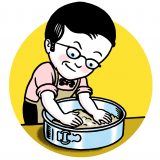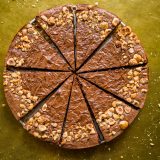
The culinary world loves a good fight, especially over nomenclature. Is a tagine a braise? When is a soup a stew? And when is a crostata (a galette in French) really a tart?
Though a true crostata is a round of pastry folded up over a simple filling, most often fruit, then baked free-form without a pie plate or tart pan, our crostata calls for a springform pan to accommodate a looser chocolate filling. Unlike a tart, however, we wanted a simple pat-in-the-pan crust that required no rolling pin and no fuss. So, let’s call this recipe a chocolate tart in the spirit of crostata!
The key to this recipe is the dough itself, which is based on a classic Italian pastry dough called pasta frolla. It differs from pate sucrée or brisée by virtue of its high sugar content. (It also contains egg, but that is common with pate sucrée.) It comes together easily in a food processor and no rolling pin is needed. Plus, you get a slightly richer, more cookie-like crust than with a typical American crust.
We were inspired by a pastry recipe from Jim Lahey’s latest book, “The Sullivan Street Bakery Cookbook,” which offers a whole-wheat version of pasta frolla. We upped the amount of whole-wheat flour (1 cup all-purpose to a ½ cup of whole wheat), as well as more butter and eggs. Lahey creams the butter, sugar and eggs in a stand mixer; we stuck with the classic pie pastry method of cutting the butter into the flour and sugar in a food processer. We also skipped the chilling of the dough since this was to be a simple pat-in-the-pan crust.
We added baking powder, not an ingredient found in classic pastry dough, to provide lift and a slightly lighter texture. Untraditional to be sure, but it worked.
We chose a classic Italian Gianduja filling—chocolate and hazelnuts. When the filling called for egg yolks and butter, it baked up greasy and broken. The answer was simple: just stick to the nuts, chocolate and sugar with vanilla, salt and egg whites, skipping the yolks. This allowed the flavor of the filing to shine through and gave us a slightly firmer texture that stood up nicely to the crust. A teaspoon of expresso powder boosts flavor.
Final testing resulted in two changes. We had to briefly pre-bake the crust to get the best texture. We simply pricked the dough with a fork; no pie weights or foil are required. We also discarded the notion of having the crust reach up the sides of the springform pan to form an edge; a simple bottom crust was all we needed since the chocolate mixture is thicker and offers more structure than a classic custard filling.
Now we had a simple, throw-together chocolate crostata (you say tart; we say crostata) that requires no rolling pin, no fuss and offers an easy, rich chocolate/hazelnut filling. It’s not as easy as pie; it’s even easier.




